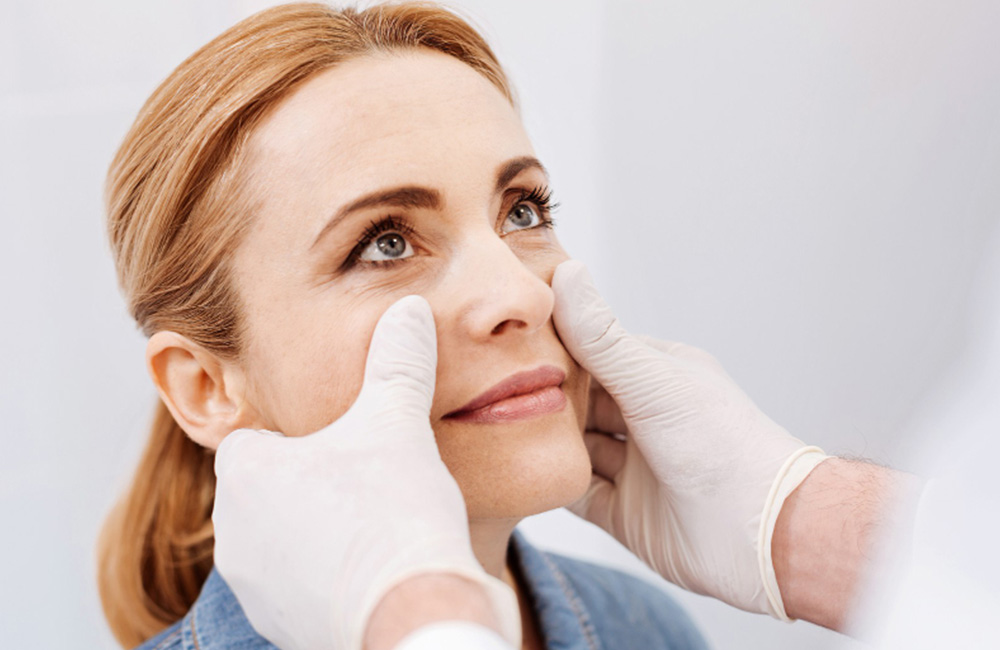Even with consistent sleep, a balanced diet, and a skincare routine, the under-eye area can still reveal signs of fatigue and aging. Hollowing, dark circles, and persistent shadows in the tear trough under eye often develop due to factors beyond your control, such as genetics, bone structure, or natural collagen loss. These changes can subtly alter your appearance, diminishing your confidence and shaping how others perceive your energy, alertness, and professionalism.
Fortunately, two advanced yet minimally invasive treatments: Platelet‑Rich Plasma (PRP) therapy and hyaluronic-acid dermal fillers, provide focused solutions for restoring volume, enhancing skin quality, and diminishing the visible signs of tiredness in the tear trough area.
While both treatments aim to beautify the under-eye area, they do so in different ways and deliver distinct results in both appearance and feel. In the following sections, we will discuss how each treatment works, what results you can expect, and how you can evaluate which method—or combination best suits you.
PRP Therapy
PRP Injections under Eyes is a regenerative, autologous treatment that uses your blood-derived growth factors to restore and renew the under-eye region. It promotes collagen production, improves circulation, and enhances skin texture, making it an effective natural treatment for mild hollowing, dark circles, and skin thinning.
Key Benefits of PRP
- 100 % natural—because it uses your own blood, there is no risk of allergy or rejection.
- Improves skin quality, texture, and color.
- No risk of overfilling or the bluish “Tyndall effect”.
- Minimal downtime (mild swelling or redness for a maximum of 24–48 hours).
How PRP Is Prepared and Applied
- Blood Draw: A small amount of the patient’s blood is drawn (typically 10–20 mL).
- Centrifugation: The blood is spun in a centrifuge, separating a platelet‑rich layer that’s about three to five times more concentrated than normal.
- Extraction: Once separated, the “golden” layer of PRP is removed. It is rich in cytokines, including platelet-derived growth factor (PDGF), transforming growth factor beta (TGF‑β), and vascular endothelial growth factor (VEGF).
- Injection: The PRP extract is injected into the tear trough region using a small needle or a blunt-tip cannula.
How Does It Work?
- Once injected, the platelets activate and release growth factors that:
- Recruit fibroblasts, stimulating collagen and elastin production.
- Promote angiogenesis, improving microcirculation and skin oxygen levels.
- Regulate melanogenesis, potentially reducing pigmentation.
Within a few weeks, the skin thickens, vascular visibility decreases, and the area appears more even, hydrated, and youthful.
Ideal Candidates for PRP
- Individuals with thin or crepey skin underneath the eyes
- Patients with vascular-type dark circles (caused by visible blood vessels and not pigment)
- People looking for a natural, autologous treatment
- First-time patients who want to avoid synthetic products or overfilling
Results After PRP Therapy
- Most people can expect to see visible enhancements in brightness and texture as early as 4–6 weeks.
- Dermal thickening and reduction in fine lines and wrinkles will become apparent by 3 months.
- Results may last anywhere from 9–18 months, especially if a course of 2–3 sessions is performed, and then maintained once per year.
Limitations of PRP
- Gradual results, not appropriate for those wanting an immediate correction.
- Need multiple treatments to achieve the improvements you want.
- The final result depends on the platelet concentration.
- Less effective for patients with deep, structural volume loss.
Summary
PRP is a great treatment for anyone looking for a natural, biologically driven rejuvenation of the under-eye area. It is particularly effective for early signs of aging, pigmentation secondary to thin skin, and someone looking for subtle, gradual changes.
Hyaluronic Acid Dermal Fillers for Tear Troughs
Hyaluronic acid (HA) fillers are sterile, cross-linked gels that restore lost volume and fix contour irregularities. They are commonly used in the tear trough area to provide immediate support and reduce hollowness.
Key Benefits of Fillers
- Provides an immediate, noticeable improvement in under-eye hollowness.
- Most patients only need one session.
- Results are predictable and precise.
- The process is fully reversible, offering flexibility and safety.
How Fillers Are Prepared and Applied
- Product Selection: Low-G-prime, soft HA fillers (like Restylane® Eyelight and Belotero Balance®) are chosen for their smooth integration into delicate tissue.
- Anesthesia: Local anesthesia or a cold compress is used, and the area is sterilized to prevent infection.
- Injection: A fine needle or cannula places the filler along the orbital rim or directly into the tear trough.
How Does It Work?
HA can hold up to 1,000 times its weight in water, providing immediate hydration and volume. Once injected:
- It restores lost volume from fat loss.
- It lifts and flattens the hollow to remove shadowing.
- It improves light reflection and facial symmetry.
Ideal Candidates for Fillers
- Patients with moderate to severe tear trough hollowness.
- Individuals seeking immediate results.
- Those with enough skin thickness to hide the filler.
- Patients who are comfortable with regular maintenance.
Results and Evidence
- Correction is often visible within minutes of treatment.
- Results usually last from 6 to 12 months, with some studies showing effects lasting up to 24 months.
- The process is fully reversible with hyaluronidase if needed.
Limitations of Fillers
- Results are temporary, require ongoing maintenance, and do not improve skin quality.
- There is a risk of bruising, swelling, and rare vascular complications.
- They may not be suitable for very thin or crepey skin, where filler visibility could be an issue.
- Fillers do not improve skin quality or pigmentation at a cellular level.
Summary
Fillers are the best option for quick under-eye correction, especially when structural hollowness is the main concern. They provide a fast and effective solution with reliable results, especially when performed by an experienced professional.
PRP vs. Fillers for Tear Troughs: A Side-by-Side Comparison
| Factor | PRP |
Hyaluronic Acid-Based Fillers |
| Effectiveness for hollowness | Builds collagen gradually; best for mild‑to‑moderate volume loss plus pigmentation | Immediately fills moderate–severe hollowing; limited effect on pigment |
| Effect on skin quality | Improves texture and discoloration over time | Primarily volumizes; does not biologically rejuvenate skin |
| Longevity | 9–18 months reported, with improvements continuing as collagen remodels (booster session may extend results) | 6–12 months typical; some lasting up to 24 months, depending on product and metabolism |
| Number of sessions | Series of 2–3 injections, 4–6 weeks apart; maintenance yearly | Usually one session; touch‑up when product fades |
| Recovery | Minimal; possible pinpoint redness, mild swelling 24–48 h | Mild swelling or bruising for 2–7 days |
| Safety & side‑effects | Autologous, so allergy is almost impossible; low vascular risk | Well studied, but carries a rare vascular occlusion and vision loss risk if misinjected |
| Ideal candidate | Early hollowing, pigment, thin crepey skin, or those who prefer “all‑natural” products | Deeper troughs, structural loss, those needing immediate correction |
Conclusion
Platelet-rich plasma (PRP) and hyaluronic acid fillers are both valid, non-invasive treatment options for tear trough concerns. Fillers immediately correct volume loss, so they may be preferable for a patient with significant hollowness who desires an instant result. Fillers, however, are temporary and need maintenance and do not offer improvement in skin quality, as compared to PRP.
PRP works from within, stimulating your body’s regenerative processes, which will gradually improve skin thickness, tone, and circulation. PRP is generally a better option for patients who desire subtle yet effective improvement without introducing synthetic substances. PRP Under Eyes is also an excellent choice for those showing early signs of aging, dark circles from vascularity, or thin, crepey skin under the eyes.
If you want a natural, low-risk, and lasting option to refresh your under-eye area, then PRP is the most appropriate treatment for you.
Are you ready to look naturally brighter? Call (206) 279-2112 and Contact us today to schedule a consultation and begin to take the first step toward restoring your rested appearance and youthful look.


